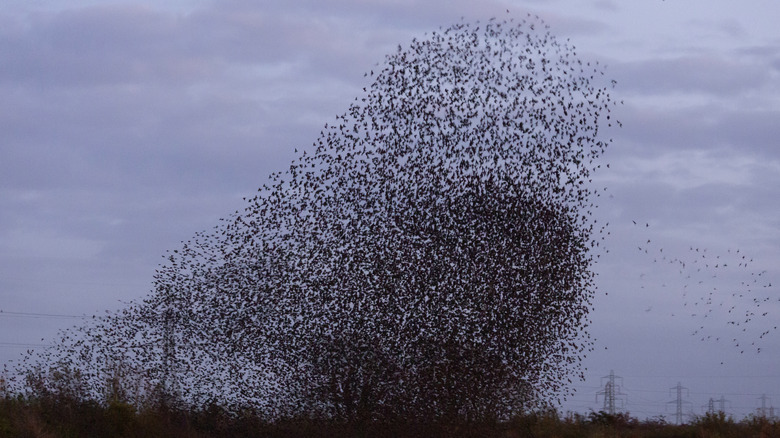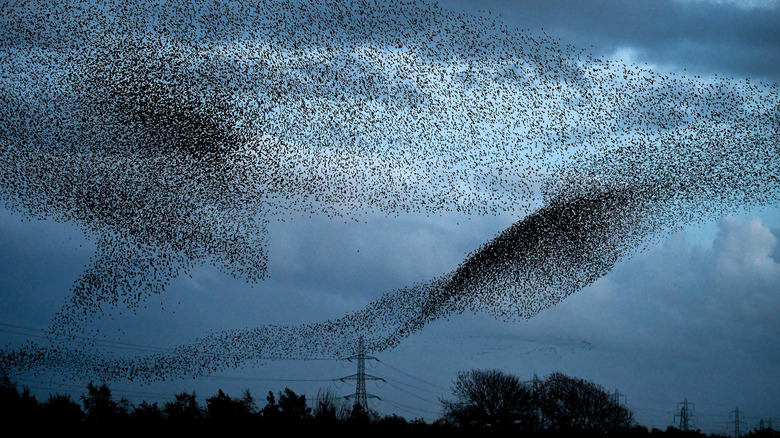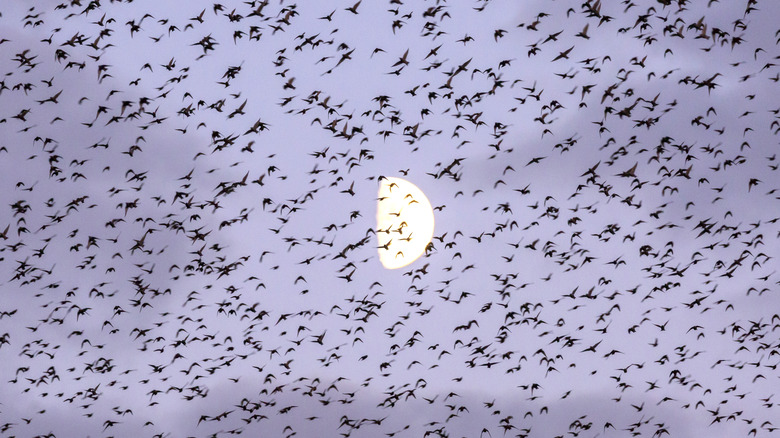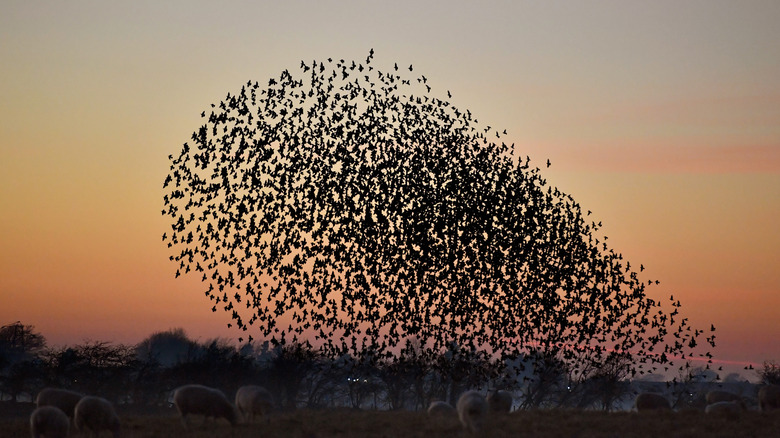Murmurations: What Are Those Swirling Groups Of Birds?
Have you ever seen something that looks like a black cloud on the horizon suddenly twist up, down, and around like a slinky in the sky? What you're seeing is a murmuration, and it's one of nature's most awe-inspiring phenomena. A murmuration is the name for a group of thousands of European starlings that fly together in a large flock and make synchronized movements in the sky, according to England's Royal Society for the Protection of Birds. The name murmuration comes from the murmuring sound of all those wings moving in unison, The Conversation explained.
Starlings only form murmurations during certain times and in certain places. The flocks can usually be seen in Europe between November and February around twilight, according to Current Biology. They typically last for 45 minutes or so and are performed near where the birds roost together, The Conversation said. The shapes the birds make as they fly have been compared to many things, including teardrops and columns. They can even take the shape of a larger bird soaring over a field, as seen in images taken by Daniel Biber (posted at World Photography Organisation). The Danish word for murmuration is sort sol, or black sun, author Helen MacDonald wrote for The New York Times Magazine. "Standing on the Suffolk coast a few years ago, I saw a far-flung mist of starlings turn in a split second into an ominous sphere like a dark planet hanging over the marshes. Everyone around me gasped audibly before it exploded in a maelstrom of wings," she wrote, describing a murmuration.
Why do they form?
Why do starlings perform these aerial dances? There are many theories. One is that the starlings want to draw more birds to them before settling down for the night in order to keep each other warmer during winter nights, according to PLOS ONE. Another is the "selfish herd" theory, that starlings gather in large groups so that any one bird is less likely to be killed by a predator like a hawk, according to Current Biology.
To test both theories, citizen scientists recorded data on more than 3,000 different murmurations, according to the resulting 2017 study published in PLOS ONE. Researchers looking at the data found that the displays were both longer and bigger when predators like hawks or peregrine falcons were present. Further, in these instances the murmuration was most likely to end with all of the birds suddenly falling into their sleeping places. There was less of a relationship between temperature and murmurations, which seemed to be slightly shorter when it was warmer. Because of this, the study authors concluded that the birds mainly evolved this habit to distract predators. However, The Conversation noted that the raptors might have been drawn to check out the swirling shapes of birds.
Nightly catch-up
Another idea is that murmurations could be ways for starlings to exchange information, sort of like meeting up with friends at a coffee shop or bar between work and sleep. This is an idea that applies to other gatherings of birds that roost or breed together, according to a 1973 study published in IBIS. Scientists suggested that these groupings could act as "information centers" to share information on where to get food.
This theory could work together with the predation-avoidance theory, because the threat of predators influences where the birds choose to roost and how they behave when together. The birds could also inform each other about the risk of predators, as Current Biology pointed out. In murmurations, starlings will sometimes form wave shapes. These have been shown to effectively thwart predators. The way that the starlings all move together away from danger is an example of them sharing information about the threat. "If a predator is detected on one end, that information is rapidly disseminated throughout the whole group, allowing a bird on the other end of the flock, perhaps dozens of meters away, to act on the same information," the Smithsonian Migratory Bird Center research associate Mario Pesendorfer told Popular Science.
How they work
How are starlings able to perform such coordinated aerial ballets? In the 1930s, an ornithologist named Edmund Selous came up with the idea that the starlings must be able to read each other's minds, according to Popular Science. Today, however, scientists know that's not the case. They think that the starlings flying in the middle can look to the borders of the murmuration and follow the overall pattern, according to The Conversation. Researchers have begun to use video cameras and three-dimensional computer models to try to understand murmuration dynamics. One study published in Behavioral Ecology in 2010 was able to create a model that accurately mimicked real murmurations by assuming each bird tracked the motion of six to seven birds closest to them.
However murmurations move, they are impressive. One in particular, the Wadden Sea murmuration in Denmark, can attract 1 million birds, according to Popular Science. And within a murmuration birds can move at speeds of 50 miles per hour, according to The Conversation. Understanding more about these displays could help researchers program "intelligent swarms" of robots that could also move together, Current Biology pointed out. These undulating clouds of birds could be the wave of the future.



